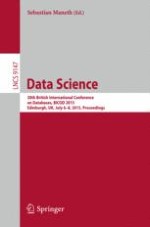This book constitutes the refereed conference proceedings of the 30th British International Conference on Databases, BICOD 2015 - formerly known as BNCOD (British National Conference on Databases) - held in Edinburgh, UK, in July 2015.
The 19 revised full papers, presented together with three invited
keynotes and three invited lectures were carefully reviewed and selected from 37 submissions. Special focus of the conference has been "Data Science" and so the papers cover a wide range of topics related to databases and data-centric computation.
